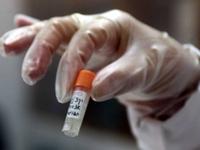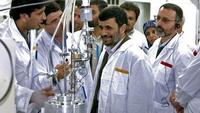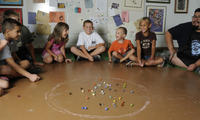-
Tiny laser sensor increases bomb detection sensitivity
New technology under development could soon give bomb-sniffing dogs some serious competition. A team of researchers has found a way dramatically to increase the sensitivity of a light-based plasmon sensor to detect incredibly minute concentrations of explosives. The researchers noted that the sensor could potentially be used to sniff out a hard-to-detect explosive popular among terrorists. The sensor also could be developed into an alarm for unexploded land mines that otherwise are difficult to detect, the researchers said.
-
-
The number of labs handling deadly germs grows, and so do calls for regulating lab safety
The number of labs handling dangerous pathogens continues to grow, and so does the number of accidents involving dangerous pathogens. The number of reported accidents involving dangerous microbes grew rapidly from just sixteen in 2004 to 128 in 2008, and 269 in 2010, the last year reported.Experts note that currently there is no single federal agency responsible for assessing overall laboratory needs — instead, departments and agencies only assess the needs for labs relative to their respective missions.
-
-
Concerns grow about CDC’s tracking, securing dangerous pathogens under its supervision
Last week, Centers for Disease Control and Prevention(CDC) officials reported that the same federal scientist who found vials of smallpox in a Food and Drug Administration(FDA) cold storage room at the National Institutes of Healthfacility in Bethesda, Maryland, also found a collection of 327 vials which could contain pathogens like dengue, influenza, and rickettsia. The new revelation adds to growing concerns about the government’s ability to track and secure dangerous pathogens under its supervision.”It is ironic that the institution that sets U.S. standards for safety and security of work with human pathogens fails to meet its own standards,” says a security expert. “It is clear that the CDC cannot be relied upon to police its own select-agent labs.”
-
-
Head of biosecurity advisory panel: Board is stalling as a result of slow fed policy work
The head of a federal biosecurity advisory committee says delays in the development of a national policy on institutional oversight of risky life-sciences research are the main reason the committee has been inactive for close to two years. The dormancy of the National Science Advisory Board for Biosecurity (NSABB) was pushed into the spotlight this week with the revelation that the eleven remaining original members of the 23-member board are being replaced. The board was set up in 2005 to advise the government on biosecurity and dual-use research, meaning research that can be exploited for harm as well as good.
-
-
Investigation finds serious violations of safety rules in CDC’s handling of deadly germs
An investigation by the U.S. Department of Agriculture’s (USDA) Animal and Plant Health Inspection Service(APHIS) conducted a review, from 23 June to 3 July, of the Centers for Disease Control and Prevention(CDC), and cited the agency for failing to follow proper procedures before and after the anthrax scare which led to the potential exposure of more than eighty lab workers to live anthrax viruses in June.APHIS found multiple violations of federal rules for handling dangerous microbes.
-
-
Tennessee man pleads guilty to attempting to extort a nuclear contractor
Adam Winters, 26, of Robbins, Tennessee, has pleaded guilty in a $2.5 million extortion case involving Babcock and Wilcox, a managing contractor at the Y-12 National Security Complex in Oak Ridge. According to Oak Ridge Today, Winters sent the contractors an e-mail on 8 May, threatening to injure their reputation by publishing roughly 1,200 slides containing evidence from nuclear testing, including the amount of radiation used on animals.
-
-
Following accidents, CDC shuts down anthrax, flu labs
Federal officials announced on Friday that they had temporarily closed the flu and anthrax laboratories at the Centers for Disease Control and Prevention (CDC) in Atlanta and halted shipments of all infectious agents from the agency’s highest-security labs. The announcement followed revelations about two recent accidents involving deadly agents at the CDC campus in Atlanta. Critics said the accidents highlighted an even greater danger – the efforts at some labs to create superstrains of deadly viruses (what is called “gain of function” research). “You can have all the safety procedures in the world, but you can’t provide for human error,” a critic of gain-of-function research said.
-
-
Smallpox vials found unguarded at NIH campus in Bethesda, Md.

Earlier this month workers clearing out a Food and Drug Administration(FDA) branch office at the National Institutes of Health(NIH) campus in Bethesda, Maryland, discovered vials containing smallpox, an eradicated agent feared for its bioweapons potential. The last smallpox samples in existence were thought to be held at tightly guarded facilities in Atlanta and the State Research Center of Virology and Biotechnologyin Novosibirsk, Russia. The vials appear to date from the 1950s.
-
-
Iran wants to expand its uranium enrichment capacity

Iran’s Supreme Leader Ayatollah Ali Khamenei said on Tuesday that Iran would need significantly to increase its uranium enrichment capacity for future energy needs, dealing a setback to negotiations between the country and world powers.
-
-
Los Alamos lab admits mishandling toxic waste, causing repository radiation leak
In a letter addressed to the New Mexico Environment Department (NMED), lab officials at Los Alamos National Laboratory (LANL) have admitted to mishandling toxic waste shipped to the Waste Isolation Pilot Plant (WIPP) in Carlsbad, New Mexico, the nation’s only permanent repository for plutonium-contaminated waste from government nuclear facilities.
-
-
Game of marbles inspires nuclear-inspection protocol

Modern cryptography combined with simple radiation detectors could allow nuclear-weapons checks to be carried out with almost complete security. That is the conclusion of scientists in the United States, who have used computer simulations to show how a beam of neutrons can establish the authenticity of a nuclear warhead without revealing any information about that weapon’s composition or design.
-
-
Engineering nuclear nonproliferation

University of Virginia engineering professor Houston Wood’s career demonstrates the important role that engineers can play in making the world a safer place. For more than two decades, Wood has helped governments determine whether nuclear programs in other parts of the world are being dedicated to peaceful or military purposes. In recent years, Wood has been working to determine the break-out time that Iran would require to develop a nuclear weapon if it stopped allowing the International Atomic Energy Agency IAEA) to inspect its nuclear facilities.
-
-
Convergence of chemistry and biology raises concerns about designer toxins
The convergence of chemistry and biology is providing major benefits to humankind, particularly in health care, alternative energy sources, and in environmental control – and when combined with other advances, particularly in nanotechnology, it is also being exploited in developing improved defensive countermeasures against chemical and biological warfare agents. This convergence, however, has also raised concerns that biotechnology could be applied to the production of new toxic chemicals, bioregulators, and toxins. A new report from OPCW says that the potential for scaling up biological processes for large scale production of chemicals of concern is still limited, but biomediated processes might still be effective for producing weaponizable quantities of toxins which are lethal to humans in microgram or lower dosage.
-
-
CDC says anthrax infection “highly unlikely,” but reassigns bioterror lab chief
The U.S. Centers for Disease Control and Prevention(CDC) has advised some of its employees to stop taking antibiotics meant to fight a possible anthrax infection after preliminary tests suggest that it is “highly unlikely” those employees were exposed to live anthrax following an incident in June. Michael Farrell, head of the CDC bioterror lab, has been reassigned.
-
-
There has been a 70% rise in civilian casualties from IEDs around the world since 2011
There has been a dramatic rise in civilian casualties from improvised explosive devices (IEDs) over the last three years, new data show. Numbers compiled from 500 English-language media reports show there was a 70 percent rise in the number of civilian casualties globally from IEDs like car bombs and suicide vests last year compared to 2011. In 2011 13,340 civilians were killed and injured by IEDs. 2013 saw this number shoot up to 22,735. In total, there have been over 60,000 deaths and injuries from IEDs in 2011-13, with civilians accounting for 81 percent of these casualties. IEDs were not limited to Iraq and Afghanistan. There were IED incidents in sixty-six different countries and territories in the last three years. Of these countries, eight — including Pakistan, Nigeria, and Thailand — saw over 1,000 civilian casualties of IEDs.
-
More headlines
The long view
Keeping the Lights on with Nuclear Waste: Radiochemistry Transforms Nuclear Waste into Strategic Materials
How UNLV radiochemistry is pioneering the future of energy in the Southwest by salvaging strategic materials from nuclear dumps –and making it safe.
Model Predicts Long-Term Effects of Nuclear Waste on Underground Disposal Systems
The simulations matched results from an underground lab experiment in Switzerland, suggesting modeling could be used to validate the safety of nuclear disposal sites.
